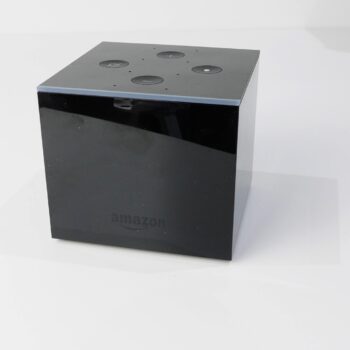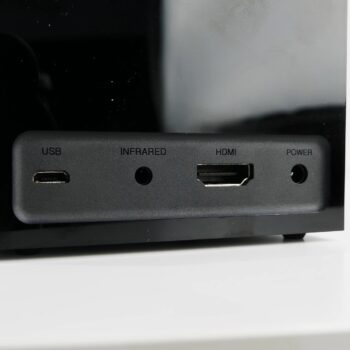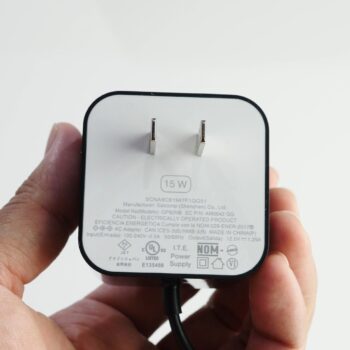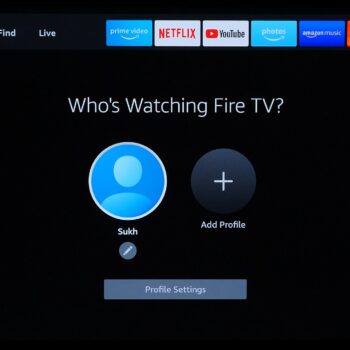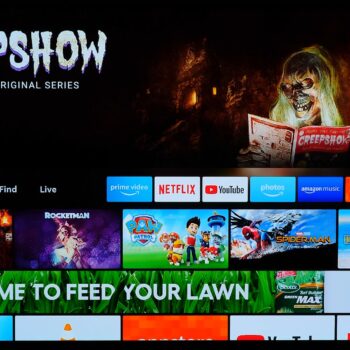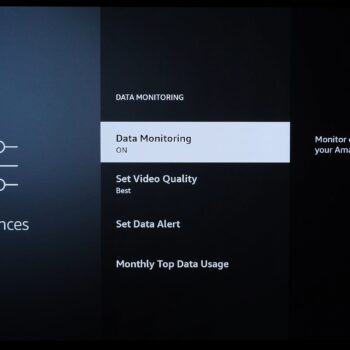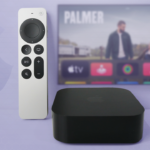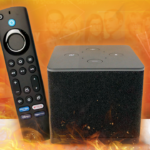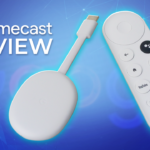In this post, I’ll be reviewing the Amazon Fire TV Cube 2019 Model. Even though this model was originally released in 2019, Amazon released a major 2021 software interface update.
This unit is pricey for a media player, costing $150 CAN or $120 USD. It’s expensive because like other Fire TV devices it has Alexa built-in but what makes it unique is that it supports Alexa far-field commands. Basically, you don’t have to tap the Alexa button on the remote to activate the smart assistant, the Cube will act like an Echo device in the sense that it’s always listening for commands. In fact, you can command it to turn on your TV and Fire TV cube by simply saying, “Alexa, turn on the TV”.
That hefty price tag also gives you the best and fastest performing Fire TV device currently available with a hexa-core processor but I won’t get into those specifics, what’s important is the performance which I’ll be commenting on later. The big bummer? With this large price tag, there’s no HDMI cable in the box…
Remote
Going back to the remote design, it’s compact, thin, and gets the job done nicely. Reaching for navigation and media controls is easy enough and as I mentioned earlier there’s the dedicated Alexa button. The remote is powered by 2 AAA batteries. Even though there are remote navigation buttons, Amazon encourages owners to tell Alexa what to play and what app to open (like, “open Netflix”). Since the remote is IR compatible, you can use it to control your TV and potentially other home theatre devices (such as power, volume, etc.).
There’s also a Fire TV remote app available for smartphones which works incredibly well and has minimal input lag.
Hardware
Switching to the Cube media player, it’s small like a compact Echo unit. It’s measuring in at 3.38 x 3.38 x 2.99”. The bottom has rubber feet to prevent any scratches if it’s placed on a glass stand. On the back, there are ports for micro-USB which allows connecting the included Ethernet adapter, but you can’t connect an external storage unit (the Cube won’t recognize it). The micro-USB port should have been USB-C instead.
Continuing on there’s a port for the IR extender, HDMI output, and port for power. Keep in mind that the power cable will take up multiple spots on a power bar as it’s a little wide. The power wire itself is 5 feet long.
On the top are Alexa controls for muting the microphone, Alexa volume controls, and an action button that enables listening for a command or turning off an alarm as (two examples).
This media player does support WiFi 5 and not 6 which I’ll let slide this time since this unit was released in 2019 and WiFi 6 was only just becoming popular at that time. It also uses Bluetooth 5.0 for headset private content listening, although I notice a fraction of a second audio sync delay. You can also connect Bluetooth gaming controllers which I’ll get back to as well as a keyboard and mouse.
It only has 16GB of internal storage which is too little at this price point, for a media player it should be at least 32GB.
The media player and remote only come in a simple black colour.
For audio, it supports Dolby Atmos, Dolby Digital, and Dolby Digital Plus. For video, it supports 4K at 60fps as well as Dolby Vision, HDR10, HDR10+, and HLG.
Software
Switching to the software side of things, it’s incredibly fast and responsive. The interface is also pretty easy to navigate. One of the first notable items on the homepage is profiles for family members. “Profiles” allows you to cater the recommendations and app layout based on your preferences.
The “Home” section is the main page. It’s primarily focused on recommending Prime content, to an excessive amount. Amazon tends to shove Prime content in your face here (and throughout most of the interface), just one section is for recommended Netflix content and no recommendations from other apps. It’s annoying how much Prime content is forced in view.
The worst part of the home screen is the banner ads… That’s right, there are ads in this section. If it’s not banner ads then it’ll be sponsored apps (just another form of ads). It’s a bit of a slap in the face as you pay a fair amount of money for this media player only to be shown ads.
Some of your most-used apps are also displayed in this section, but by default, some of them are Amazon apps that you might not ever use (surprise), such as Amazon Photos.
The “Find” section allows you to search for new apps to install and content to watch. You can use the on-screen keyboard in this section to search, use the Alexa button on the remote or say the Alexa command out loud for the Cube to process.
The great thing about Alexa on this media player is that it’s the full working version of the smart assistant. So in addition to working with the search function, it’ll work with all Alexa compatible smart devices.
The “Live” section is mainly designed for apps that will broadcast live sports and news.
There’s an “Appstore” section to download more apps but for some reason, there’s no search function to find more apps. To search for apps, you have to go back to the “Find” section or use Alexa.
The “Appstore” has access to your typical popular media apps such as Apple TV, YouTube, Plex, Netflix, Disney+, Hulu, and Prime Video (Prime is preinstalled). App availability will vary depending on where you live.
Since this media player is running Android at the core, you can sideload apps (more information here). Note that when sideloading apps, there’s no guarantee it’ll work if the app isn’t compatible.
When it comes to responsiveness and general speed, this media player is great. After all, it’s currently the fastest Fire TV media player. When it comes to opening apps and playing media content, it’s quite fast.
Plex is an interesting story. The app can play H.264 and H.265 compressed files in mp4 and mkv file format in 720p, 1080p, and 4K just fine. There were only two exceptions to this case. One file I have is compressed quite heavily in H.265 in mkv file format and 4K. The Cube will play it for about 30 minutes, buffer and stop. The only way to continue playing is by exiting the video and playing it again.
The next special case for Plex is large files, such as raw videos from my camera that plays back at 150Mbps (that’s large), 4K, H.264 in mp4. Plex will play it for a few seconds, then buffer, play for a few seconds, buffer, and so on. I’m not sure where the bottleneck in performance is. It could be the network since WiFi is only WiFi 5 and not 6. Even if the micro-USB Ethernet adapter is used, the adapter is only 10/100 so this is definitely too slow.
There’s no way to test the processor performance since files can’t be copied locally to the internal storage. I tried connecting my USB stick with content to the media player using a USB A to micro-USB fitting and it seems that Amazon purposely blocked the Cube from reading externally connected files. I tried sending files over WiFi to the external storage and apps like Plex and VLC can’t see them, again Amazon blocks efforts to play my own files. This is a huge bummer at this price tag.
The two exception files I used won’t apply to most people but it’s just something I wanted to mention.
Going over the Fire TV Stick “Settings”, most of it is generic stuff found on other media players. Here are the interesting ones though:
-Equipment Control – Here you can connect other home theatre devices if they’re compatible with the Cube IR remote control. This means you could control other devices with one remote.
-Remote and Bluetooth – This section allows you to pair Bluetooth headsets for private listening (as mentioned earlier) and the ability to pair gaming controllers for Xbox One, Xbox Series S/X, PS4, and PS5 (clicking on a link will take you to a guide explaining how to pair that controller).
-Preferences – You can activate parental controls to block mature content and prevent kids from making purchases. This section also allows you to control playback quality in case you have a limited monthly internet data usage cap.
When it comes to playing games, I tested Asphalt 8. I know Asphalt 9 is out but I purposely skipped that since only Asphalt 8 is available for the Fire TV Stick 2020 (1080p player) and Fire TV Stick 2018 (4K player). I chose to use Asphalt 8 as a benchmarking game. On the 2018 and 2020 Fire TV Sticks, the game would drop in frames slightly. On the Cube, the frames drop even less (sometimes never) which is evidence that the Cube is the fastest Fire TV device ever made.
Score:
7.5/10
Pros:
-IR home theatre control
-Compact remote
-Alexa voice assistant
-Alexa smart home control
-Fire TV remote app
-Compact design
-Bluetooth supports game controllers, keyboard, and mouse
-Bluetooth private headset listening
-Most popular streaming apps available
-App store
-Fast and responsive
-Easy to use interface
-Sideload apps
-Profiles
-Parental controls
-Data usage controls
-Great quality video playback
-Dolby: Atmos, Digital & Digital Plus
-HDR: HDR10, HDR10+, HLG
Cons:
-Price
-Ethernet adapter isn’t USB-C
-Slow Ethernet adapter
-Excessive push for Prime content
-Ads
-No HDMI cable
-Internal storage space
-Can’t connect external storage

